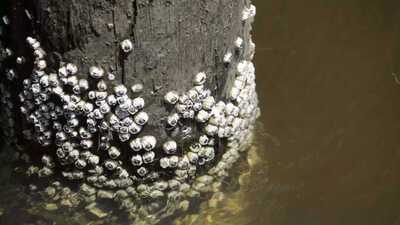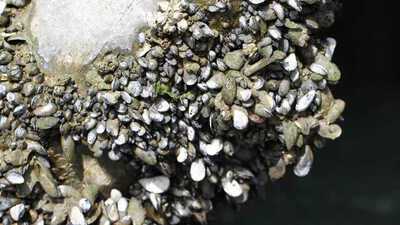Have you ever noticed tiny, white, volcano-like bumps on a boat hull, a rock, or even a sea turtle, and wondered what they are and how they stay glued even after being in water for so long?
Barnacles cling so tightly to whatever they land on that their hold can outlast the creature itself. The secret is a remarkable natural glue and a carefully staged way of sticking that scientists are still decoding, and trying to copy.
What are barnacles?
Barnacles are crustaceans that are born as larvae. At the final larval stage, called a cyprid, they search for a place to settle.
The cyprid first uses temporary, reversible adhesives to test surfaces and then, once it commits, the young barnacle secretes a permanent cement from specialized glands and metamorphoses into a sessile adult. That cement is not a single chemical but a complex, insoluble proteinaceous material made for underwater bonding .

Why is the grip so strong?
Barnacle “glue” is a cocktail. It contains multiple cement proteins that self-assemble into a dense, insoluble matrix right at the attachment interface. Before the proteins set, barnacles also secrete lipids and other compounds that sweep away water, biofilm, and contaminants so the proteins can make close contact with the surface.
This two-step strategy, clear the surface, then lay down a protein network that hardens and resists dissolution, helps explain why barnacles stick where ordinary adhesives fail.
Molecular tricks that beat superglue in the sea
Unlike mussels, which rely heavily on a catechol chemistry (DOPA) to bond underwater, barnacle adhesives use a different set of design rules: a set of complementary proteins that bind each other and the surface through a mix of hydrophobic packing, steric complementarity, and crosslinks that create a cohesive film only micrometres thick.

Some barnacle proteins also form amyloid-like fibers and include enzymatic or metal-mediated steps that lock the cement into a virtually insoluble state. These features assemble in place and cure in seawater, something synthetic glues generally cannot do.
Barnacle cement adheres to rock, metal, plastics, paint and living skin, and it can survive decades of waves and salt. That durability has attracted bioengineers: teams have built barnacle-inspired adhesives that stick to wet, bloody tissue and can seal wounds in seconds in animal tests.
Researchers hope to translate barnacles’ multi-component, surface-clearing plus protein-assembly strategy into surgical glues and robust underwater sealants.
Barnacles cling so tightly to whatever they land on that their hold can outlast the creature itself. The secret is a remarkable natural glue and a carefully staged way of sticking that scientists are still decoding, and trying to copy.
What are barnacles?
Barnacles are crustaceans that are born as larvae. At the final larval stage, called a cyprid, they search for a place to settle.
The cyprid first uses temporary, reversible adhesives to test surfaces and then, once it commits, the young barnacle secretes a permanent cement from specialized glands and metamorphoses into a sessile adult. That cement is not a single chemical but a complex, insoluble proteinaceous material made for underwater bonding .
Why is the grip so strong?
Barnacle “glue” is a cocktail. It contains multiple cement proteins that self-assemble into a dense, insoluble matrix right at the attachment interface. Before the proteins set, barnacles also secrete lipids and other compounds that sweep away water, biofilm, and contaminants so the proteins can make close contact with the surface.
This two-step strategy, clear the surface, then lay down a protein network that hardens and resists dissolution, helps explain why barnacles stick where ordinary adhesives fail.
Molecular tricks that beat superglue in the sea
Unlike mussels, which rely heavily on a catechol chemistry (DOPA) to bond underwater, barnacle adhesives use a different set of design rules: a set of complementary proteins that bind each other and the surface through a mix of hydrophobic packing, steric complementarity, and crosslinks that create a cohesive film only micrometres thick.
Some barnacle proteins also form amyloid-like fibers and include enzymatic or metal-mediated steps that lock the cement into a virtually insoluble state. These features assemble in place and cure in seawater, something synthetic glues generally cannot do.
Barnacle cement adheres to rock, metal, plastics, paint and living skin, and it can survive decades of waves and salt. That durability has attracted bioengineers: teams have built barnacle-inspired adhesives that stick to wet, bloody tissue and can seal wounds in seconds in animal tests.
Researchers hope to translate barnacles’ multi-component, surface-clearing plus protein-assembly strategy into surgical glues and robust underwater sealants.
You may also like

US Designates Balochistan Liberation Army & Its Alias Majeed Brigade As Foreign Terrorist Organizations

Teacher raped boy, 11, after bringing him round her house for 'play dates'

Madras HC to hear today plea against Chennai corporation's private sanitation contract

South African president urges gender equality across policies during Women's Month

'We'll show them what's next': After Indus dam, Pak Army Chief Asim Munir now fixes target on RIL Jamnagar refinery






